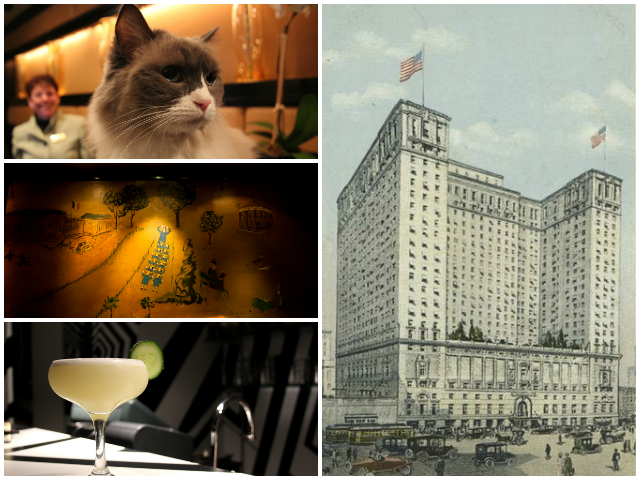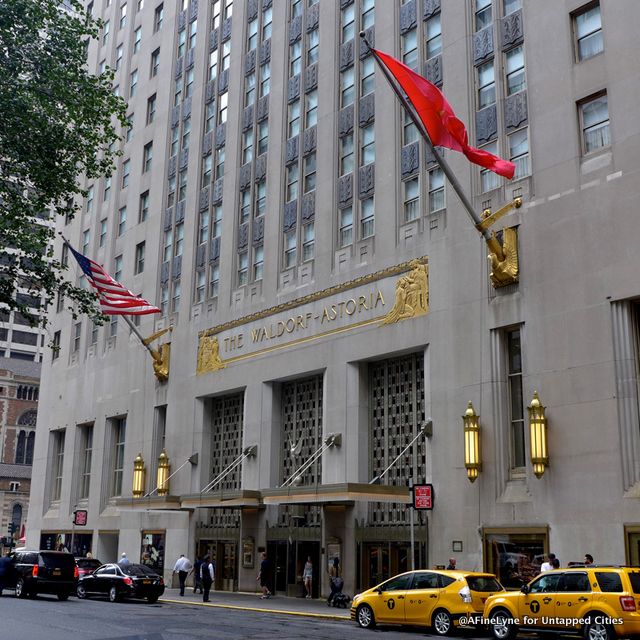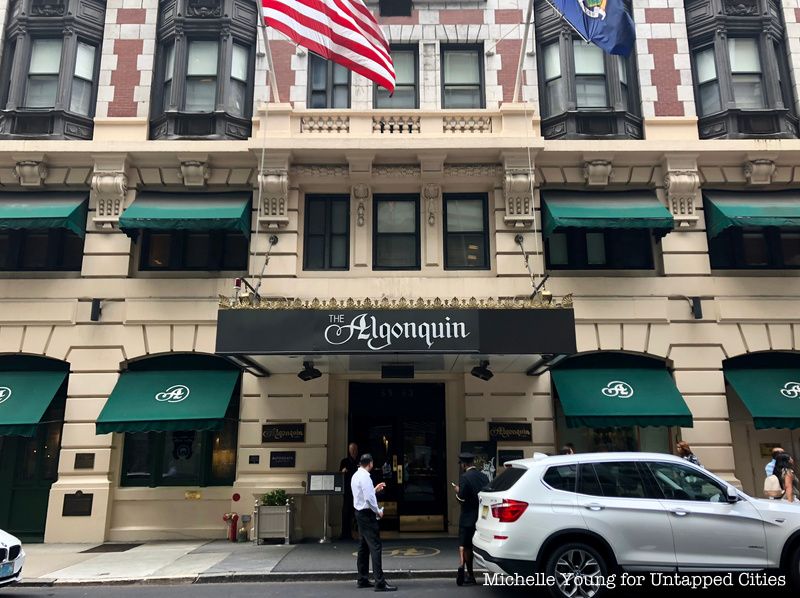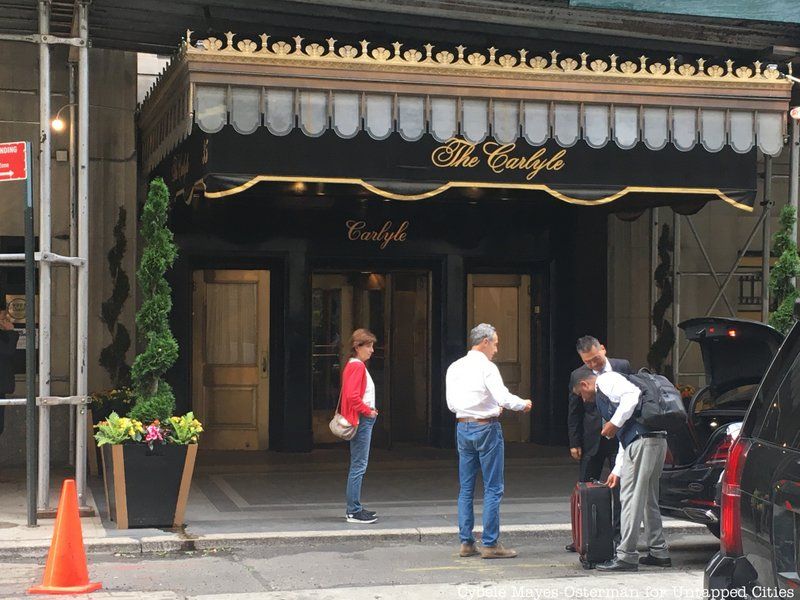Last Chance to Catch NYC's Holiday Notalgia Train
We met the voices of the NYC subway on our nostalgia ride this weekend!



Whether built by American royalty (namely the Astors and the Hearsts) or by immigrants pursuing the American Dream like Charles Pierre, their shared dedication to excellence in hospitality serve as the foundation to New York City’s premier hotels.
Besides impeccable hospitality taken as a given at all of these establishments, each of these hotel are renowned for its originality. Visit these hotels for murals, the birthplace of world famous cocktails and the storied haunts of aristocrats, presidents, industrialists and Hollywood stars.

The philosophy of excellence in hospitality Charles Pierre learned while working at his father’s Monte Carlo hotel, apprenticing at Sherry’s and establishing Pierre’s Park Avenue restaurant as the favorite haunt of New York City high society still lives on at the Pierre. Designed by Schultze & Weaver, the hotel opened in 1930 and was acquired by Taj Hotels Resorts and Palaces of India in 2005.
The French chateau inspired building, which occupies the site of the former Elbridge T. Gerry mansion, dominates the Upper East Side and its place in New York City history as the gold standard in hospitality.

Enjoy a slice of New York City nautical history at the former American Seamen’s Friend Society Sailors Home and Institute. Resembling its sister building, the Ellis Island immigration station, this warm brick hotel by William A. Boring housed Titanic survivors in its rooms which ironically were designed to resemble cabins aboard a ship.
The West Village outpost, built in 1908, was home to a bowling alley, a concert hall and a chapel, and was restored on its centennial in 2008.

The famed Waldorf-Astoria Hotel has a quintessential New York City-origin story. It began as a family feud and rivalry between two very wealthy cousins who shared the last name Astor. William Waldorf Astor proceeded to irritate his cousin John Jacob Astor by building a 13-story hotel on the corner of Fifth Avenue and 33rd Street, on a residential block where John Jacob’s mother lived. Four years later, John Jacob, in turn, built a 17-story hotel just a few feet away–and the rest is history. Today, the Waldorf ranks amongst the finest hotels in the world. It was also the first hotel to introduce room service and continues to lead hospitality industry.
That’s why the closing of the historic Waldorf Astoria hotel in March 2017 for a renovation into condos hit a nerve for many of us. The Waldorf-Astoria hotel proper will be reduced in size and the remaining sections repurposed into condo apartments. During renovations, you can see the famous lobby clock at the New-York Historical Society. This continues a trend already extant inside the Waldorf Astoria: The Waldorf Towers has been a separate residence since 1931. Also, check out the Secrets of the Waldorf-Astoria Hotel.

Located at 59 W. 44th Street in New York City’s Theater District in Midtown Manhattan, the Algonquin Hotel has stood as the oldest hotel in the city and the gathering place for many of the city’s celebrities, from writers to actors. Despite changing hands a few times in the last few decades, the hotel still maintains its literary and celebrity reputation, appearing also in many movies.
Since its opening in 1902, the Algonquin has hosted Nobel laureates and the first unaccompanied single women guests allowed to lodge at hotels. Designated as a New York City landmark in 1987 and as a literary landmark in 1996, this hotel’s literary legacy is matched by impeccable service.
Also, read about the Algonquin’s resident cats, Hamlet and Matilda, who sadly passed away in October.

Suitably named after the patron saint of travelers, St. Regis was built by John Jacob Astor IV in 1904 as the tallest New York City hotel in the most exclusive residential area. Noted for its opulent interior and furnishings from the Old World by its aristocratic, royal, entertainment and politician guests since the opening, this “home away from home” continues to cater to the most discerning travelers.
One of the highlights of the hotel is the King Cole Bar where the Bloody Mary was invented.

Murals on 54 in the Warwick Hotel
Publishing tycoon William Randolph Hearst built the hotel as a love nest for him and his mistress actress Marion Davies and as a place to host his Hollywood friends who frequented the Ziegfield Theater across the street. Built for Hollywood and with an impressive guest list with the the likes of Elvis Presley, Elizabeth Taylor and the Beatles, the Warwick is without a doubt one of the most star-studded hotels in New York City.
A unique feature of the hotel is the Murals on 54 restaurant based around a series of murals by Dean Cornwell in 1937 depicting Sir Walter Raleigh and the lost colony at Roanoke.

One of the first to lead the way in the interwar trend for residential hotels, the Carlyle was dubbed one of the first skyscraper communities. Also called the New York White House, President John F. Kennedy maintained a residence in the Carlyle and used a network of tunnels under the hotel and famously rendezvoused with Marilyn Monroe.
The Bemelmans Bar in the hotel features murals by Ludwig Bemelman (creator of the children’s book series Madeline) that depict the four seasons in Central Park and continues to delight the socialites, politicians, entertainers and tourists who frequent the bar.

First opened in 1906, the Knickerbocker Hotel was constructed on land owned by John Jacob Astor IV, at the time one of the wealthiest men in the world. Developers J.E. and A.L. Pennock capitalized on the emerging popularity of the area, which had recently been renamed Times Square in 1904 at the behest of Adolph Ochs, owner of The New York Times when the newspaper made the move uptown. In October of the same year, the IRT opened its first subway line, ushering in an unprecedented wave of businesspeople, entertainers, and theatergoers to an area that, when it was Longacre Square, had been known for adult entertainment and prostitution. But the new wave of higher class entertainment and theater reshaped the neighborhood’s character, and the innovative Knickerbocker was sure to herd people directly to its amenities by way of its platform entrance before they even had a chance to make it to street level.
Replete with Beaux-Arts details on its facade and a 30-foot mural by artist Maxfield Parrish within, the hotel came to the forefront of New York’s high society scene. Its fortunes were short-lived, as ownership was transferred to Vincent Astor following his father’s death on the Titanic in 1912. By 1921, the hotel was closed down and the building saw time hosting Newsweek’s headquarters and garment showrooms. The Subway station beneath has notably expanded to become the busiest in the system, and today the platform that the door sits beside provides access to the 42nd Street Shuttle. FelCor Lodging Trust purchased the Knickerbocker in 2012 with the intent of reconfiguring it back into a hotel, and a grand opening is scheduled for fall of this year.

The Ansonia about 1904. Image from Library of Congress
The Ansonia Hotel went up even before the opening of the subway, from 1899 to 1904. Developer William Earl Dodge Stokes was the so-called “black sheep” of his family–one of nine children born to heiress Caroline Phelps and banker James Stocks. Stokes predicted that Broadway would one day surpass the renown of Fifth Avenue to become the most important boulevard in New York City, the city’s Champs-Élysées. The Ansonia Hotel would herald these changing times, located in a prime location on 73rd Street just one block north of the subway station.
One thing to keep in mind is that the term hotel in the time period of the Ansonia meant a residential hotel, more like if you combined today’s luxury apartments with a full-service concierge and housekeeping staff. The French-inspired building, with its mansard roof, contained 1,400 rooms and 230 suites across 550,000 square feet. Pneumatic tubes in the walls delivered messages between staff and residents. A wonderful spiral grand staircase of marble and mahogany led up to a skylight seventeen floors up. At maximum capacity, the ballrooms and dining rooms could accommodate 1,300 guests.

For over a century, New York City commuters have passed through Grand Central Terminal, Warren & Wetmore’s Beaux Arts masterpiece. However, most people are unaware that Grand Central Terminal does not stand on its own. The original plans by Reed & Stem, along with William John Wilgus, called for an entire city to accompany their train station.
Terminal City was to include a new home for the Metropolitan Opera and the National Academy of Design, as well as a 20 story post office building, office space, and hotels. While this vision was not realized, Terminal City did become a reality after many revisions. One of the most important aspects of the complex was its grand hotels, including The Vanderbilt.In 1912, Alfred Gwynne Vanderbilt I commissioned Warren and Wetmore to construct a hotel at 34th Street and Park Avenue. Alfred Vanderbilt was the son of third son of Cornelius Vanderbilt II and grandson of Commodore Vanderbilt and he grew up in this stately mansion (whose remnants still abound). While the facade was restrained, with terra cotta flourishes, its interior was full of amenities and state of the art technologies, including pneumatic tubes. The Della Robbia Room was located in the hotel’s basement and was architecturally noted for its Gustavino ceiling.Vanderbilt had the top two floors of the hotel transformed into a private house for his family. He lived there until 1915 when he tragically died on the Lusitania after giving up his life jacket. In 1925, the Vanderbilts sold the hotel and in 1967, the hotel was converted into a mixed-use building (upper floors apartments and lower floors offices). In 1966, the hotel’s new owners began to remove its fanciful terra cotta and the architects Schuman, Lichtenstein & Claman reclad the lower portion of the building. All was not lost. In 1994, the Della Robbia Bar (now Wolfgang’s Steakhouse) was designated an interior landmark by the New York City Landmarks Preservation Commission.
Next, check out Grand Central Terminal: Terminal City and its Hotels.
Subscribe to our newsletter